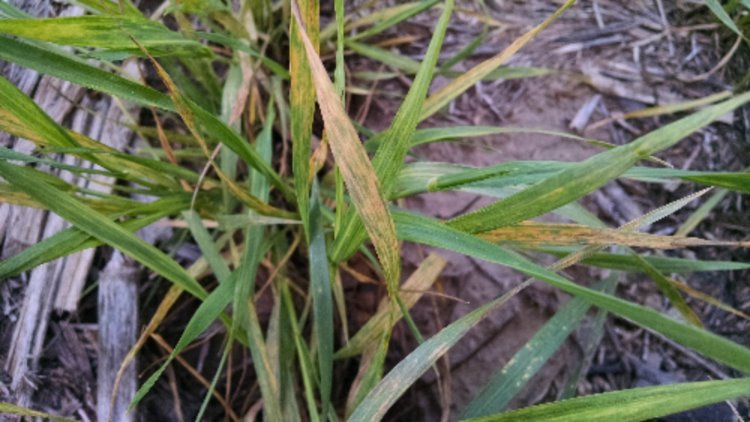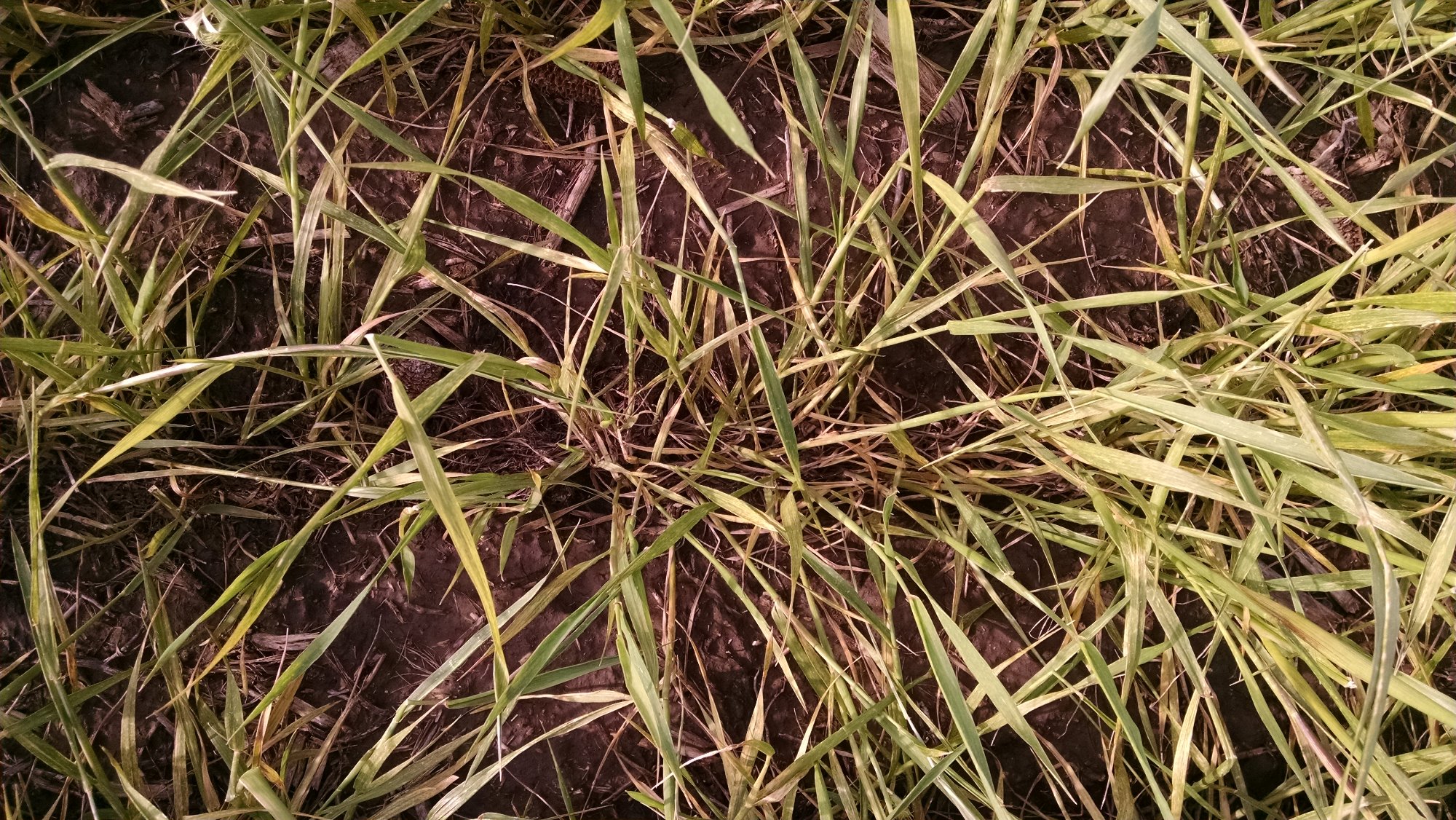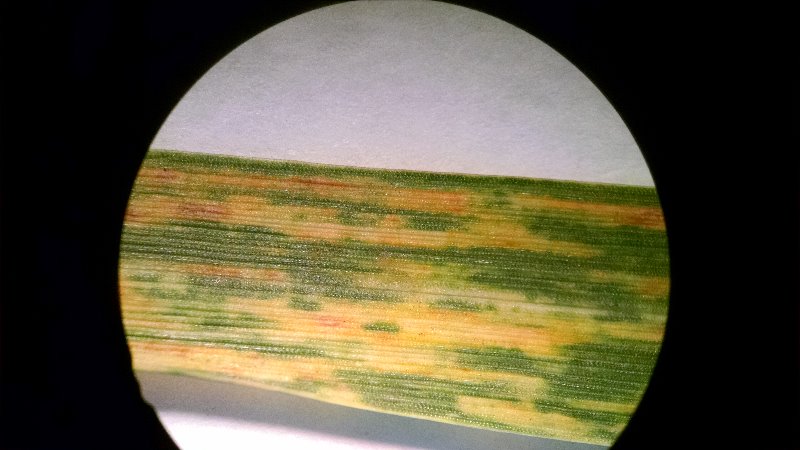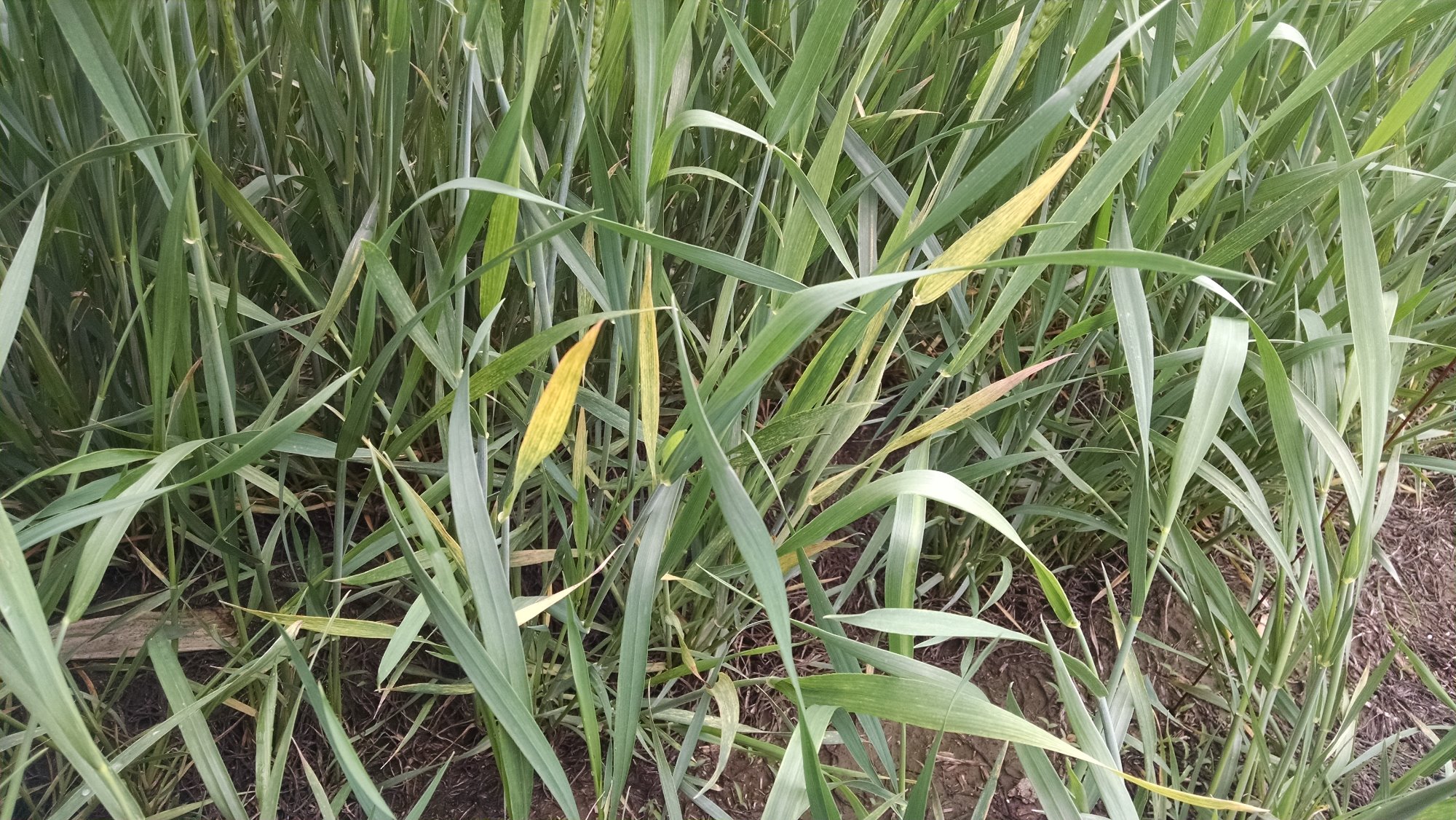Wheat Streak Mosaic
Useful Links:
K-State Wheat Disease and Insect Ratings
Wheat Streak Mosaic
Wheat streak mosaic is a virus that is vectored by the wheat curl mite. Plants infected with wheat streak mosaic have a bright yellow streaking on the leaves of the plant. Symptoms are often most severe near the leaf tip. The virus that causes wheat streak mosaic survives in volunteer wheat and is moved by the wheat curl mite. The disease is often most sever in areas of a field that are closest to these sources of the disease and mites. Commonly plants infected with wheat streak mosaic are also infected with High Plains mosaic and Triticum mosaic. The symptoms of these diseases are nearly identical. Disease severity is greater when plants are infected by more than one virus.

Mottled appearance on wheat leaves. Photo by Jeanne Falk Jones, K-State Agronomist.

Severe wheat streak mosaic infestation in wheat. Notice how the wheat has a relaxed appearance, rather than upright. Photo by Jeanne Falk Jones, K-State Agronomist.

Close up under a microscope of wheat streak mosaic. Photo by Jeanne Falk Jones, K-State Agronomist.

Wheat Streak Mosaic virus showing on leaves of a plant. They are a very noticeable bright yellow color. Photo by Jeanne Falk Jones, K-State Agronomist.
Controlling Volunteer Wheat to Lessen Chances of Wheat Streak Mosaic
Have you walked through your wheat stubble lately? How about your neighbor's wheat stubble? It might be worth spending a few minutes now looking because it could help your (or your neighbor's) yields this next harvest!
Every year at about this time, you hear "Control your volunteer wheat." This is especially important this year with the large number of small kernels that were kicked out of combines at harvest. We have had enough moisture to sprout and now we have volunteer wheat.
The primary reason for this is to decrease the threat of wheat streak mosaic virus infecting newly emerged wheat. Wheat streak mosaic virus can be devastating to a wheat field. This virus is moved by the wheat curlmite. These mites live on volunteer wheat during the summer and rely on it as a food source. They are microscopic and cannot be seen with the naked eye. In addition, the mites are highly mobile and can travel up to 1/2 mile on wind currents!
It is critical that all volunteer wheat within 1/2 mile be completely dead at least two weeks prior to planting. Volunteer wheat can be controlled by working the ground or by herbicide application. Grazing volunteer is not an effective option because there is green wheat material left and the mites can be living in that material.
As the summer progresses into fall, these mites are looking for a new food source...and what better than young, tender, juicy wheat plants that have just emerged. The worst case scenario is that the volunteer is dying, just as the new wheat is emerging.
Fall infections of wheat streak mosaic are the most devastating to the wheat crop. However, infections can take place until late spring. The fall infections are the most detrimental to the crop because the plant is young and not completely established.
Think of the wheat streak mosaic virus like the flu virus in humans. It is the toughest on the young because they have a harder time fighting off the virus. In addition, there is no medicine or treatment to cure the virus. Wheat that is stressed will be more susceptible to severe symptoms. This includes stress from drought, lack of nutrients, or poor growing conditions. The only difference is that humans can fight off the virus and wheat cannot fight it off.
So, take a few minutes and check for volunteer wheat. It may save your (or your neighbor's) wheat yields this next harvest. If you have any questions on wheat streak mosaic or controlling volunteer, please contact me at the Extension Office.
-Jeanne Falk Jones
Latest Report on Wheat Streak Mosaic (May 19, 2015) from Jeanne Falk Jones
As everyone is out looking for stripe rust in their fields, wheat streak mosaic is also being found. The wheat streak mosaic is characterized by yellowing plants, with leaves that have a mottled yellow and green appearance. In many cases, the virus showing up in patterns that we are most accustomed to. These include increased severity on one side of the field, where it seems all plants are infected. The severity of the symptoms generally decrease as you move across the field, away from the source.
The source is generally thought of as volunteer wheat because it harbors the wheat curl mite. The wheat curl mite is a tiny insect that moves the wheat streak mosaic virus. As it feeds on new wheat material, it transfers the virus to the plant. There are other plants on which the wheat curl mite can live. These include corn and several grasses found in the road ditches – including foxtails and sandbur. These tiny mites need green material to live on and die after just a few days if they do not have the green tissue. There was also no shortage of volunteer wheat last summer, likely because of the hail events in June and very early July. The mites also rely on wind to move them to their next food source.
The thing that is challenging this year is the fact that the patterns in the field do not match up with what we typically think of as wheat streak mosaic patterns. It seems the most common pattern in the field is really no pattern at all, but randomly scattered groups of plants with the mottled green and yellow symptoms on the leaves. These plants are also fairly easy to see because the yellowed plants stand out against the other green, healthy plants.
Upon visiting with both an entomologist and plant pathologist, it seems the cause of the scattered plants is likely related to a heavily infested, but distant source of the wheat curl mites. The wheat curl mite population diffused as it moved further from the main source. With the long, warm fall the wheat curl mites would have had ample time to move around and infect wheat plants. In addition, there is likely something that may have prevented the population from getting well established in the wheat. It is possible that the cold snap in November may have helped suppress the mite population or prevent it from getting established in a field.
In addition, there is a lag period between the infection of the wheat streak mosaic and the expression of the symptoms of the virus. The virus must reach a certain level within the cell before the symptoms will show on the leaves. The virus also replicates at different rates, based on the growth stage of the wheat plant and the temperature. The rate of virus replication increases with increasing temperatures. That is why it seems that the symptoms started showing up after some rain (wheat started growing) and warmer temperatures (virus increased in rate of replication).
Finally, there is nothing that can be done to treat the wheat streak mosaic virus. Once it is in the cells of the plant, there is nothing that can be done to control the virus. Minimizing stress on the plant is the best medicine to minimize the effects of the disease.